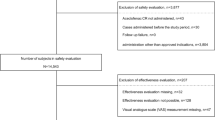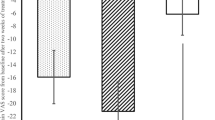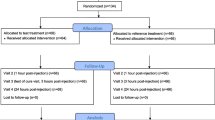Abstract
Tizanidine and aceclofenac individually have shown efficacy in the treatment of low back pain. The efficacy and tolerability of the combination have not yet been established. The objective of the study was to evaluate the efficacy and safety of aceclofenac-tizanidine fixed dose combination against aceclofenac alone in patients with acute low back pain. This double-blind, double-dummy, randomized, comparative, multicentric, parallel group study enrolled 197 patients of either sex in the age range of 18–70 years with acute low back pain. The patients were randomized to receive either aceclofenac (100 mg)–tizanidine (2 mg) b.i.d or aceclofenac (100 mg) alone b.i.d for 7 days. The primary efficacy outcomes were pain intensity (on movement, at rest and at night; on VAS scale) and pain relief (on a 5-point verbal rating scale). The secondary efficacy outcomes measures included functional impairment (modified Schober’s test and lateral body bending test) and patient’s and investigator’s global efficacy assessment. aceclofenac–tizanidine was significantly superior to aceclofenac for pain intensity (on movement, at rest and at night; P < 0.05) and pain relief (P = 0.00) on days 3 and 7. There was significant increase in spinal flexion in both the groups from baseline on days 3 and 7 with significant difference in favour of the combination group (P < 0.05). There were significantly more number of patients with excellent to good response for the aceclofenac–tizanidine treatment as compared to aceclofenac alone (P = 0.00). Both the treatments were well tolerated. In this study, aceclofenac–tizanidine combination was more effective than aceclofenac alone and had a favourable safety profile in the treatment of acute low back pain.




Similar content being viewed by others
References
Batlle-Gualda E, Román Ivorra J et al (2007) Aceclofenac vs paracetamol in the management of symptomatic osteoarthritis of the knee: a double-blind 6-week randomized controlled trial. Osteoarthr Cartil 15(8):900–908 Epub 26 March 2007
Berry H, Hutchinson DR (1988) Tizanidine and ibuprofen in acute low-back pain: results of a double-blind multicentre study in general practice. J Int Med Res 16:83–91
Burton AK, Waddell G (1998) Clinical guidelines in the management of low back pain. Baillieres Clin Rheumatol 12:17–35. doi:10.1016/S0950-3579(98)80004-6
Carey TS, Garret J, Jackman A et al (1995) The outcomes and costs of care for acute low back pain among patients seen by primary care practitioners, chiropractors, and orthopedic surgeons: The North Carolina Back Pain Project. N Engl J Med 333:913–917. doi:10.1056/NEJM199510053331406
Cherkin DC, Wheeler KJ, Barlow W, Deyo RA (1998) Medication use for low back pain in primary care. Spine 23:607–614. doi:10.1097/00007632-199803010-00015
Desmeules J, Rollanson V, Piguet V, Dayer P (2003) Clinical pharmacology and rationale of analgesic combination. Eur J Anaesthesiol Suppl 28:7–11
Dooley M, Spencer CM, Dunn CJ (2001) Aceclofenac: a reappraisal of its use in the management of pain and rheumatic disease. Drugs 61(9):1351–1378
Ehrlich GE (2003) Back pain. J Rheumatol Suppl 67:26–31
European Commission COST B13 Management Committee (2002) European guidelines for the management of low back pain. Acta Orthop Scand Suppl 73:20–25
Fryda-Kaurimsky Z, Muller-Fassbender H (1981) Tizanidine (DS 103–282) in the treatment of acute paravertebral muscle spasm: a controlled trial comparing tizanidine with diazepam. J Int Med Res 9:501–505
Hagen KB, Hilde G, Jamtvedt G, Winnem M (2004) Bed rest for acute low back pain and sciatica. Cochrane Database Syst Rev (4):CD001254
Hildebrandt J (2004) Does unspecific low back pain really exist? Z Orthop Ihre Grenzgeb 142:139–145. doi:10.1055/s-2004-822623 in German
Jackson KCII (2004) Pharmacotherapy in lower back pain. Drugs Today (Barc) 40:765–772. doi:10.1358/dot.2004.40.9.850496
Jensen S (2004) Back pain: clinical assessment. Aust Fam Physician 33(393–395):397–401
Lepisto P (1981) Muscle relaxants for nonspecific low back pain: a systematic review within the framework of the Cochrane Collaboration. J Int Med Res 9(6):501–505
MacRae IF, Wright V (1969) Measurement of back movements. Ann Rheum Dis 28:584–589. doi:10.1136/ard.28.6.584
Manek NJ, MacGregor AJ (2005) Epidemiology of back disorders: prevalence, risk factors, and prognosis. Curr Opin Rheumatol 17:134–140
Million R, Hall W, Nilsen KH, Baker RD, Jayson MIV (1982) Assessment of the progress of the back pain patient. Spine 7:204. doi:10.1097/00007632-198205000-00004
Raffa RB, Clark-Vetri R, Tallarida RJ, Wertheimer Al (2003) Combination strategies for pain management. Expert Opin Pharmacother 4:1697–1708. doi:10.1517/14656566.4.10.1697
Rossignol M, Abenhaim L, Bonvalot Y, Gobeille D, Shrier I (1996) Should the gap be filled between guidelines and actual practice for management of low back pain in primary care? Spine 21:2893–2898. doi:10.1097/00007632-199612150-00021
Schattenkirchner M, Milachowski KA (2003) A double-blind, multicentre, randomised clinical trial comparing the efficacy and tolerability of aceclofenac with diclofenac resinate in patients with acute low back pain. Clin Rheumatol 22(2):127–135
Van Tulder MW, Tunt M, Pennick V et al (2004) Quality of primary care guidelines for acute low back pain. Spine 29:E357–E362. doi:10.1097/01.brs.0000137056.64166.51
Acknowledgments
This study has been sponsored by Ipca Laboratories Limited. The authors would like to thank Ms. Smita Talekar, for her technical assistance right from the inception of the study, and Mr. Mitesh Sharma, biostatistician for statistical analysis and data management for this study. Dr. Anil Pareek and Nitin Chandurkar, who are employees of Ipca Laboratories Limited, were involved in the conceptualization, coordination and execution of the study at all the centres. The experiment complies with the current laws of the country in which they were performed inclusive of the ethics approval.
Author information
Authors and Affiliations
Corresponding author
Rights and permissions
About this article
Cite this article
Pareek, A., Chandurkar, N., Chandanwale, A.S. et al. Aceclofenac–tizanidine in the treatment of acute low back pain: a double-blind, double-dummy, randomized, multicentric, comparative study against aceclofenac alone. Eur Spine J 18, 1836–1842 (2009). https://doi.org/10.1007/s00586-009-1019-4
Received:
Revised:
Accepted:
Published:
Issue Date:
DOI: https://doi.org/10.1007/s00586-009-1019-4




